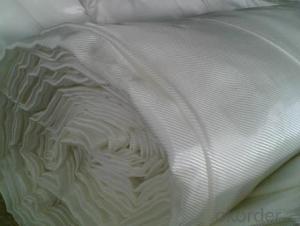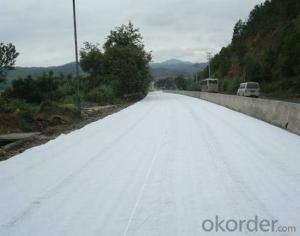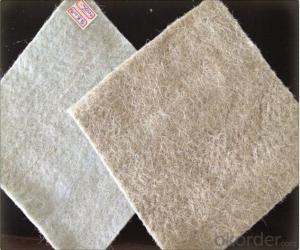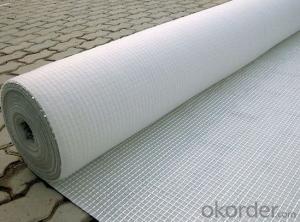Pet Geotextile - Excellent PP Woven Geotextile for Road Engineering
- Loading Port:
- Qingdao
- Payment Terms:
- TT or LC
- Min Order Qty:
- 20000 m²
- Supply Capability:
- 1500000 m²/month
OKorder Service Pledge
OKorder Financial Service
You Might Also Like
1. Specifications of PP Woven Geotextile for Road Construction
1) Weight / Mass: 75g/m2-800g/m2 .
2) Width: Within 8 m (1m-8m).
3) Length: 50m-100m/roll (as request).
4) Material: PP/PET.
5) Color: Black , white , grey, others
6) Certificate: CE/ISO9001, ISO14001 .
7) Manufacturing method: nonwoven / woven.
8) The equipment is introduced from Germany.
9) This geotextile can be made of polypropylene (PP), or polyester (PET), Polyvinyl or synthetic fiber on needle punch machine.
10) The mass is available from 75g/m² to 800g/m² and the width available from 1.0m-8m, monolayer or multilayer (reinforcement geotextiles), long fiber or short fiber.
11) Color: all kinds of color are available. The annual production ability is 10 million square meters.
12) The fabric can also be heat treated by infrared at customer's requirements. Our geotextile are UV stabilized to give protection against aging under exposure to natural ultra-violet light.
2. Introduction of PP Woven Geotextile for Road Construction
Geotextiles are composed from synthetic polypropylene/polyester fibres through a mechanical process of needling the fabric and adding, when necessary, a thermo fused process, resulting in a uniform porous structure with excellent tensile strength and chemical deterioration. Type: 1. Wovens & knitted: use various fibre types (e.g. monofilament, multi-filament, split extruded film) in different combinations. 2. Non-wovens: staple or continuous fibres that are heat treated or needlepunched to “fix” fibres relative to each other.
FAQ:
What is the main application of PP Woven Geotextile for Road Construction?
The main application of our PP Woven Geotextile for Road Construction
is as follows: The highway, railway, soil-stone dam, breakwater, airport, backfill soil of retaining wall, slope protection, etc.
Where is your main market?
Our main market is in Middle East, South America and some African countries.
What is your advantages for PP Woven Geotextile for Road Construction?
One of the largest manufacturer of Needle Punched Nonwoven Geotextile for Highway Construction with advanced equipment, big production capacity and excellent quality.

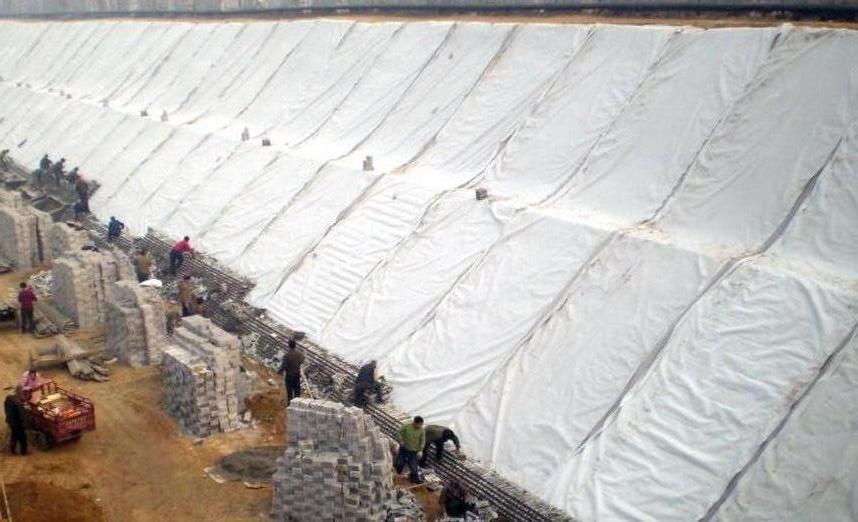
This Geotextile Fabric 101 guide contains some tips that you should know before buying. When it's time to do some landscaping or build an addition to your house, preparing the soil is an important first step. You don't want weeds, vines or even excess water to get in and contaminate your project. One very popular way to solve this challenge is by using long sheets of geotextile fabric materials. They are made with special properties that will serve to protect the investment you make in your landscaping or construction project for many years. Geotextiles are fairly straightforward, but it is important to know what they are and what features they offer before making any kind of buying decision.
What is a Geotextile Fabric?
Geotextiles are simple and permeable sheets of fabric which come in rolls and can be rolled out on the ground when a barrier is needed. These sheets are made of a special fabric that has special characteristics for your landscaping or construction needs. For example, one feature is that they help separate sections of your soil by acting as a barrier between the deeper areas and the surface (where your plants or other project arrangements are located). They can block out unwanted weeds and growth from coming to the surface and still allow drainage of excess water that you don't want in the area. The main benefits of such a fabric are that: i) your plants and landscaping won't suffer from unfair competition posed by weeds and roots, and ii) the area won't become inundated with water. It's like an additional helpful hand for your garden or construction site. Geotextile fabrics can act in this way because they are typically composed of polypropylene or polyester materials.
How Much Do I Need?
Before going out to buy a geotextile fabric, you should determine exactly how much you need. Typically, it's best to lay down enough sheets to cover the whole surface area. Remember that these sheets are rolled up. While a single roll will correctly cover all of your project's length, you will need to use several rolls to cover the whole area. Also, it is a good rule of thumb to have about 15% of each sheet overlapping above the next sheet in order to prevent any holes or gaps in between. While small breaks or ruptures in the fabric aren't a big deal, you definitely want to avoid the formation of large holes because that allows room for weeds to grow through. And that defeats the whole purpose of using the geotextile fabric.
Another good thing to keep in mind is how dense you want the sheets to be. A denser layer means less water will be able to pass through and there will be less risk of having unwanted plants come through as well. However, this will cost more and may not be needed if you have soil that is already in good condition. You should consider and make your decision about this before you start researching the different types and prices.
Bottom Line
Overall, geotextile fabric is a great tool that you should use when doing landscaping and certain construction work. It can help you on many levels, such as preventing unwanted weeds and allowing proper water drainage. Just keep in mind the type of material you need, the quality and the number of rolls required and you'll be all set with your geotextile fabric needs.
- Q: What are the key properties of geotextiles?
- Geotextiles are permeable fabrics made from synthetic materials, such as polyester or polypropylene, and are primarily used in civil engineering and construction projects. The key properties of geotextiles include high tensile strength, excellent filtration capabilities, good durability, and resistance to biological degradation. They also provide effective drainage, soil stabilization, and erosion control, making them a versatile solution for various applications in geotechnical engineering.
- Q: Can geotextiles be used in geotechnical engineering projects?
- Yes, geotextiles can be used in geotechnical engineering projects. Geotextiles are permeable fabrics that are commonly used to enhance the performance and stability of soil in various geotechnical applications, such as erosion control, soil stabilization, drainage systems, and reinforcement of weak soils. They can improve the overall strength and durability of the soil, prevent erosion, and provide filtration and drainage capabilities.
- Q: Split silk geotextile and filament geotextile relative price which is cheaper
- Split silk geotextile and filament geotextile relative price which is cheaper
- Q: Are geotextiles suitable for use in geotextile-reinforced soil walls?
- Yes, geotextiles are suitable for use in geotextile-reinforced soil walls. Geotextiles provide strength, stability, and erosion control to the walls, making them an effective and commonly used material in reinforcing soil structures.
- Q: How do geotextiles contribute to soil stabilization?
- Geotextiles contribute to soil stabilization by acting as a barrier that prevents soil erosion, reduces sedimentation, and improves overall soil strength. They provide reinforcement by distributing loads and preventing soil particles from moving, thus stabilizing the soil and preventing slope failures. Additionally, geotextiles promote moisture retention and drainage, enhancing the soil's stability and preventing water-induced damage.
- Q: River slope protection geotextile unit area quality is generally how much
- Geotextile width of 2-6 meters. Length can be customized according to the requirements, generally 100g - 1000g specifications, per square meter. I am specializing in the production of geotextile materials, welcome you, hope to adopt!
- Q: How do geotextiles help with ground reinforcement?
- Geotextiles help with ground reinforcement by providing a stable and durable layer that helps distribute load, reduce soil erosion, and improve soil stability. They prevent the mixing of different soil layers, improve drainage, and enhance the overall strength and integrity of the ground.
- Q: Tunnel without sand concrete, geotextile, seepage blind pipe construction sequence
- In accordance with the order of seawater blind pipe geotextile sandless concrete, I specialize in producing geotextile materials
- Q: Reservoir dam waterproof geotextile cloth two bags of a large package should be how much money
- Wages in 4 yuan a square. I specialize in producing geotextile materials
- Q: How do geotextiles help with moisture management in construction projects?
- Geotextiles aid in moisture management in construction projects by acting as a barrier against water infiltration and promoting drainage. They are permeable fabrics that allow water to flow through, preventing water buildup and potential damage to structures. Geotextiles also help to stabilize soil, control erosion, and separate different soil layers, further enhancing moisture management in construction projects.
Send your message to us
Pet Geotextile - Excellent PP Woven Geotextile for Road Engineering
- Loading Port:
- Qingdao
- Payment Terms:
- TT or LC
- Min Order Qty:
- 20000 m²
- Supply Capability:
- 1500000 m²/month
OKorder Service Pledge
OKorder Financial Service
Similar products
Hot products
Hot Searches
Related keywords




